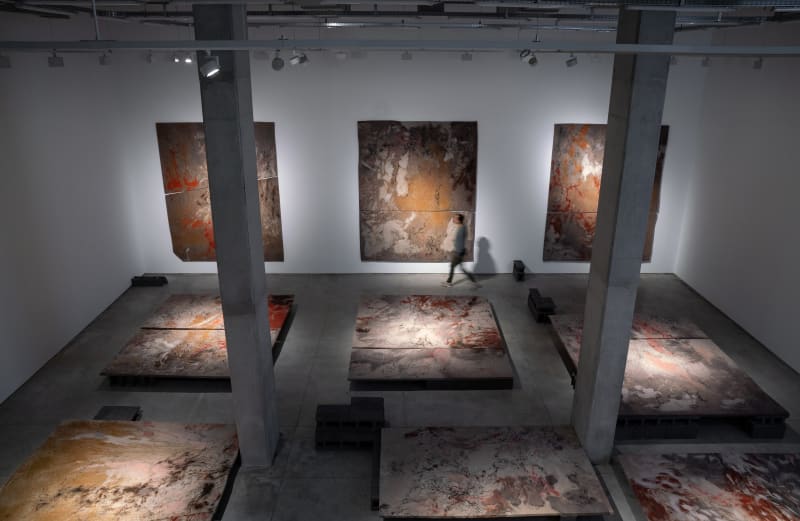Monia Ben Hamouda's exhibition ‘Ya'aburnee’ at Selma Feriani Gallery in Tunis is titled after the Arabic concept that translates as ‘you bury me’, reflecting the selfless wish for a loved one to outlive oneself. Love and sacrifice, omnipresent in the exhibition, explore the complex ideas of language, history and understanding through an installation that spans the three floors of the gallery, combining painting, sculpture and sound pieces, blurring our relationship with space. These recordings from two mosques create a haunting landscape that blends religious calls to prayer with urgent public announcements. It transforms the familiar sounds of the call to prayer into an alarming melody, reflecting a complex interplay between spirituality and the pressing need for information in times of crisis. The installation evokes discomfort and awareness, as the low vibrations resonate throughout the gallery. Ben Hamouda aims to capture the distinct auditory landscape of Arabic countries, emphasizing how these sounds shape cultural identity and perception. The result is a powerful commentary on the nature of communication and the emotional burden carried by these calls in our troubled area.
At the heart of the gallery are nine paintings exploring the narrative construction of art history. Some of them are lying on the floor like so many tombs. Painted by the force of spices thrown onto the canvas by the artist, they evoke familiar scents akin to the soil of a homeland—a place we feel a connection to through a deep call to the land, even if we are not born there. Drawing inspiration from ancient artefacts such as the Rosetta Stone, Ben Hamouda imagines alternative historical narratives and questions our understanding of ancient civilisations as if essential translations had never taken place. The artist alludes to ‘prehistoric’ art forms, such as cave paintings and pieces of marble carved with a language that has yet to emerge. She suggests that language itself could be treated as a sculptural material, adaptable to fit our diverse cultures.
The Rosetta Stone, which presented familiar yet initially incomprehensible scripts, echoes Ben Hamouda’s work in creating a visual language that is simultaneously recognizable and enigmatic. This reflects philosopher Abdelbebir Khatibi's notion of a "plural language" that transcends binary cultural identities. Her approach to linguistic architecture parallels the monumentality of language history. Her use of ancient inscriptions alike embodies the weight of cultural memory and the power of words to transcend time. In the artist’s work, language becomes a monument that simultaneously evokes recognition and eludes complete understanding.
Ya'aburnee whispers of an ancestral memory that defies translation, a heritage language both intimate and inscrutable. Jenny L. Davis, an indigenous poet, captures this temporal and cultural chasm with her haunting question: “What song / would you sing for them?”. The mosque's call to prayer, rising from the gallery's depths, carries with it the weight of generations—a tapestry of joy, sorrow, triumph, and struggle woven into its ancient rhythms. In this polyphonic landscape of human longing, we find ourselves searching for a common tongue. As the world struggles to find harmony, we're reminded of Babel's fractured legacy, playing out in real-time before our eyes. How do we speak to be understood when the very act of communication seems to push us further apart?
From Ya'aburnee rises a song that still resonates in the vestiges of our ancestors and grandmothers. The exhibition embodies the enigma of recognising a presence that eludes all comprehension. It manifests itself as a tangible tapestry of accumulated history, a visual chronicle that is both palpable and impenetrable. It stands before us like a monument to memory, reflecting the paradox of a language that exists in form but remains shrouded in mystery - a testament to the enduring yet elusive nature of our cultural heritage.
Ibn Khaldun would likely view Ben Hamouda's installation as a manifestation of his cyclical theory of civilizations, where civilisations rise and fall in predictable patterns. The artist's installation, much like Khaldun's concept of dynasties containing the seeds of their own downfall, delves into the decay of cultural and political structures. Monia Ben Hamouda's work, bridging worship and archaeology, resonates with the current situation in Palestine, where the cyclical nature of the conflict has transformed land into sites of historical trauma. It echoes the artist's exploration of attachment to the soil as motherland, raising profound questions about the preservation of identity and memory in the face of dispossession.
‘Ya'aburnee’ creates a poignant environment that invites contemplation of cultural heritage and the enduring power of love.
